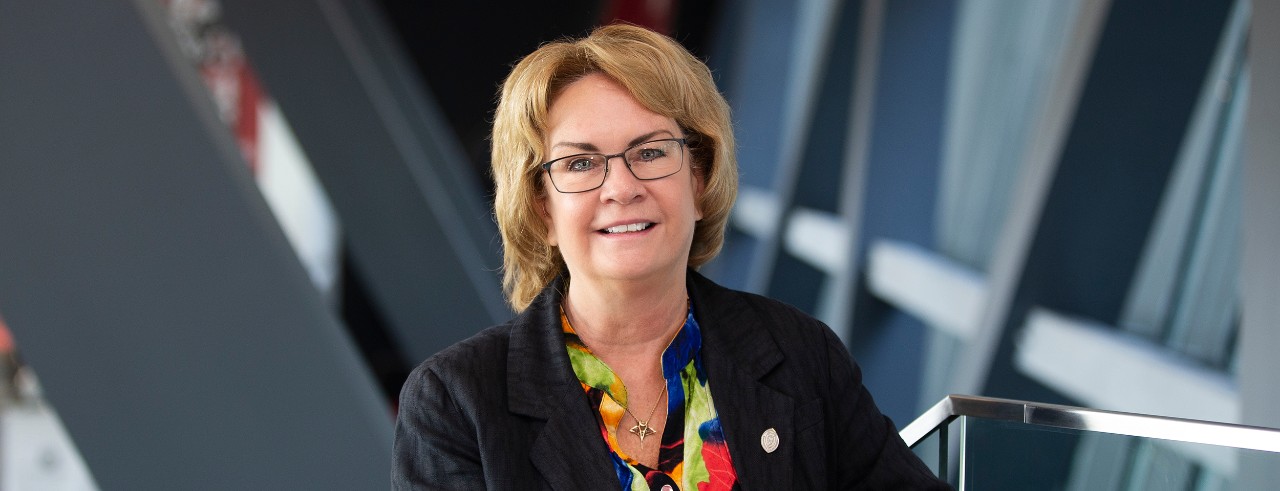
UC Answers: How are researchers responding to COVID?
Research dean from College of Medicine says labs kept churning despite pandemic
Melanie Cushion, PhD, is senior associate dean for research at the University of Cincinnati College of Medicine. She is a professor in the Department of Internal Medicine and a senior research career scientist at the Cincinnati Veterans Affairs.
How are the College of Medicine's laboratories operating amid these new COVID-19 guidelines?
As of Oct. 1, research labs at the College of Medicine have been given the greenlight by the university to return to full capacity because they demonstrated their ability to observe the suggested COVID-19 precautions and prevent transmissions.
During the initial shutdown in March, only labs performing critical research were permitted to remain open with minimal staff necessary to complete experiments. Critical research is defined as the coronavirus SARS-CoV-2 studies, ongoing animal studies or other studies that would, if interrupted, result in a loss of critical scientific data.
In June a gradual recall of research lab personnel began with just a quarter of the staff, eventually to half and finally three-quarters of the regular staffing based on the lab's ability to prevent any viral transmission in the laboratory setting.
The College of Medicine accounts for more than two-thirds of research funding at UC. How is COVID-19 impacting the college's research mission?
The College of Medicine finished fiscal year 2020 with the highest research holdings in 10 years, hitting $133 million, which was $25 million more than the previous year and almost a 30% increase. We are on track in the first quarter of fiscal year 2021 to meet or even beat the previous year which is also amazing. Our researchers are eager to remain in the lab with their research programs running at full capacity and have been very observant of the mandated precautions.
What are some of the things UC researchers learned as a result of COVID-19?
Some realized that we could work efficiently at home. And we caught up with paperwork and submitted more grants. We realized that many meetings could be held on a virtual format, decreasing travel time and unnecessary automobile trips. Because of the stress involved with this unknown virus, we have also become aware of the need for wellness programs in stress reduction.
How has wellness factored into the college’s response?
We have all become very aware of wellness and how important it is because being sequestered at home for extended lengths of time has a lot of implications for our mental health. People are really taking this seriously. Many have gone out of their way to show kindness to their coworkers. The College of Medicine, the dean and senior associate deans instituted a program that formally recognizes these acts of kindness with a custom-made gratitude mask. We award 10 gratitude masks per week, and so far a total of 150 have been given. It’s really nice to see, and we have opened this up to faculty, staff and personnel. We really don’t want to leave anyone out.
What are some of the behind-the-scenes efforts that are taking place as it relates to COVID-19 that the average person might not realize?
On March 17, we transitioned to working remotely. We sent out a call for proposals focusing on studying various aspects of the novel coronavirus and the disease it causes, COVID-19. Researchers were given eight days to write the proposal. We received 29, reviewed them with notices of award to 11 chosen projects going out on April 8.
This is less than a month after the initial call. So this is record time. Notable accomplishments from these projects included the launch of a phase-two clinical trial for treatment of hospitalized patients. A diagnostic investigative procedure for SARS-CoV-2 is under development, including gathering evidence for interactions of the SARS-CoV-2 virus, which then helps us understand the pathology of cardiovascular disease induced by this virus. Seven published manuscripts and five under review are focusing on the acute lung injury induced by the COVID-19 patients within their lungs, which is where the virus initially gains entrance to the body.
A blueprint of the coronavirus was published, focusing on the enzyme that allows double-stranded RNA and DNA to unwind, which allows the virus to replicate. We've also seen development of a system to screen compounds active against reducing viral entry, not using the coronavirus itself, but a surrogate for a safer and more efficient way for screening potential inhibitors. We're also developing T-cell therapy for treatment using convalescent T-cells, which are stimulated with spike proteins. And from a practical basis, we have a group that is evaluating different fabrics for homemade masks materials. Those will be field tested this month.
Impact Lives Here
The University of Cincinnati is leading public urban universities into a new era of innovation and impact. Our faculty, staff and students are saving lives, changing outcomes and bending the future in our city's direction. Next Lives Here.
Stay up on all UC's COVID-19 stories, or take a UC virtual visit and begin picturing yourself at an institution that inspires incredible stories.
Related Stories
Two UC-backed startups score $200K each from state
December 23, 2025
Innovative startup ventures TapIn and Saturn Sports rose from the UC Venture Lab to receive $200,000 each in funding through Ohio Third Frontier grants.
UC College of Nursing Professor honored with AANA education excellence award
December 23, 2025
Susan Newell, assistant professor in the UC College of Nursing, is being recognized by the American Association of Nurse Anesthesiology (AANA) as one of three top educational administrators and instructors. She will receive the Clinical Instructor of the Year Award during AANA's top educator event 2026 EDGE Conference, February 4-7 in Louisville, Kentucky.
A partnership to end pancreatic cancer
December 19, 2025
Since 2010, BSI Engineering has raised more than $1.2 million for pancreatic cancer research at the University of Cincinnati Cancer Center in honor of a friend and inspiration to BSI’s founders, Bryan Speicher.
